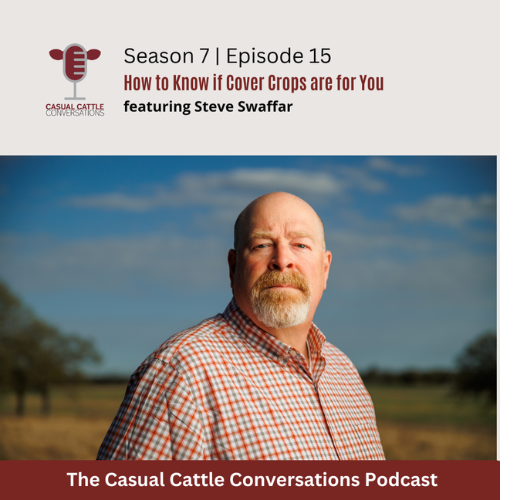The Casual Cattle Conversations Podcast: How to Know if Cover Crops are for You
Thursday, April 11, 2024
Reference: Podcast Corner

How to Know if Cover Crops are for You
April 8, 2024 | Written By Shaye Koester
When you hear the word crop, it’s easy to start thinking about farming and disassociate how it could pertain to ranching if you aren’t a diversified operation. Yet, cover crops are a valuable practice for both farmers and ranchers. Steve Swaffar said, “Soil health is what drives the discussion around cover crops and just as the word says, it's a tool to keep the soil covered. It's a tool to add diversity to your soil. But for the livestock producer, it's also an appealing forage source. So, we see a pretty good opportunity for marriage between the pure farmer and the pure rancher in that overlap.” Steve Swaffar shared how cover crops can be beneficial to both farmers and ranchers along with how to get started in Season 7, Episode 15 of the Casual Cattle Conversations podcast.

Click Here to listen to Shaye's Podcast
What does regenerative mean?
The terms regenerative, holistic, conservation and sustainability are all thrown around frequently and are similar but not the same. Depending on who you are visiting with, their definitions can vary too. The term regenerative itself separates itself from others from the standpoint that is about improving or moving forward. “We had the era where holistic was a big buzzword for a while. And then we entered into sustainability and sustainable was a big buzzword for a while, and now we're into regenerative. And they've essentially all been talking about the same thing. You can get into the nitty gritty of definitions, and everyone's going to have a different definition of sustainability and holistic and regenerative. But I think everyone's just trying to get down to the same root of the problem, which is we're trying to make the connection between the way ecology exists, functions and is meant to function in an effort to create a synergy between the ecology, livestock production and running a profitable business,” said Word. Additionally, these words are used to market animal proteins and connect with consumers about the common value of caring for natural resources.Which practices are regenerative?
Regenerative principles and the practices being paired with this term have been around for generations. So, what determines if a specific management practice is considered regenerative or not? “You hear the term regenerative practices a lot. I'm not sure such a thing exists to me. Regenerative agriculture and regeneration in general, is based on principles. So, a regenerative practice doesn't necessarily exist, because regeneration is an outcome that we're trying to achieve. And there are lots of different ways to do that. It comes down to how you apply the practice, because any given practice can achieve a regenerative or degenerative outcome depending on different climates, different rainfall areas and other factors relating to the operation. It is more complex than just practices. It's how you apply principles,” said Word. Livestock producers need to have a clear understanding of this concept to share the most accurate picture of agriculture, especially if the term is being used in marketing tactics to connect with consumers outside of agriculture.How do you start implementing regenerative principles?
The amount of hype around regenerative principles can make doing research and finding a starting point feel overwhelming, especially when you hear of people moving cattle multiple times each day. The reality is regenerative principles can look like simple changes that allow you to start out slow. “A lot of producers who make the switch from so-called conventional agriculture to regenerative ranching will tell you that two years ago, the time that I spent on the tractor baling hay or putting out fertilizer, which are not bad, are just now spent moving the herd, fences and water. I wouldn't say it's more time intensive, I just think you spend your time doing different things,” said Word. Caitlin encourages producers interested in focusing more on regenerative principles to start small, so you don’t make too many changes at once that result in something you can’t handle.Mindset is also an important component of making any changes because your management practices are tied to your business model. When you change one, you impact the other regardless of if it is a slow or fast change. Caitlin said, “When people's mindset changes, you start to look at things differently, and you start to gauge your success differently. Your definition of success changes along with the outcomes you are seeking to be successful. So when your mindset changes about your management practices, I think your mindset about your business model and goals also changes. A lot of the time you see this gradual change happening all throughout the operation.” This being said, changing a few practices doesn’t have to completely change your goals and current operation. They may in fact, compliment what you are already doing.
If you are interested in learning more about regenerative principles and how they can be applied to your livestock operation, reach out to others in your area who already have success with these principles or head to www.Noble.org for access to various resources and courses. It’s exciting to see livestock producers continue to commit their energy into leaving the land better than they found it generation after generation.
Sign up to stay connected
- News
- Property Alerts
- Save your favourite properties
- And more!
Joining Farm Marketer is free, easy and you can opt out at any time.
